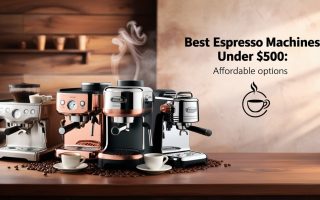The journey from bean to cup is filled with choices that can significantly impact flavor and aroma. One of the most crucial decisions you’ll face is selecting the right grinder. When it comes to coffee grinders, two main contenders stand out: blade grinders and burr grinders. While both are designed to break down coffee beans, they each bring their own unique approach and results to the table.
Imagine waking up to the rich aroma of freshly ground coffee wafting through your kitchen. The key to achieving that perfect cup lies in how uniformly your beans are ground. Blade grinders, often touted for their affordability and simplicity, can be tempting for the casual coffee drinker. However, the burr grinder, with its reputation for consistency and quality, appeals to those who appreciate the finer nuances of flavor.
In this article, we’ll dive deep into the differences between blade and burr grinders. We’ll explore their mechanics, the quality of the grind they produce, and how each option fits into your coffee routine. Whether you’re a coffee novice or a seasoned enthusiast, understanding these grinders will empower you to make the best choice for your brewing needs. Let’s embark on this journey together and find out which grinder is the perfect match for your coffee adventure!
How Coffee Grinders Work
To truly appreciate the difference between blade and burr grinders, it’s essential to understand how each one operates. At its core, a coffee grinder’s primary job is to break down coffee beans into smaller particles, allowing for the optimal extraction of flavors during brewing. However, the methods they employ vary significantly, leading to different results in grind consistency and flavor profile.
Blade Grinders: These are the underdogs of the coffee grinding world. Typically more affordable and straightforward, blade grinders feature a set of sharp blades that spin rapidly to chop up the beans. When you push the button, those blades whir into action, creating a whirlwind that reduces the beans to your desired size. While this sounds efficient, the reality is that the grind size can vary widely. You might find some beans pulverized into a fine dust while others remain frustratingly whole. This inconsistency can affect the extraction process, potentially leading to a bitter or underwhelming cup of coffee.
Burr Grinders: On the other hand, burr grinders offer a more refined approach. These grinders use two revolving surfaces, or burrs, to crush the beans rather than chop them. As the beans are fed through the grinder, they pass between the burrs, which can be adjusted to create a uniform grind size. The result? A consistent texture that allows for even extraction during brewing. Whether you prefer a fine grind for espresso or a coarser texture for French press, burr grinders can be finely tuned to meet your needs. This precision is what makes them the go-to choice for coffee aficionados who demand the best from their brews.
In essence, understanding how these grinders work sheds light on why they produce such different results. While blade grinders might suit those seeking convenience on a budget, burr grinders are ideal for those who see coffee as an art form—where each grind is a step toward that perfect cup. Now that we’ve unraveled the mechanics behind these grinders, let’s dive into the various types available in each category!
Types of Blade Grinders
When it comes to blade grinders, the landscape is as varied as the flavors in your morning cup. While they might be simple in design, different types cater to distinct preferences and needs. Let’s explore the main categories of blade grinders, highlighting their features and how they can fit into your coffee routine.
1. Manual Blade Grinders: Picture a compact, hand-cranked device that invites you to take a moment in your coffee-making ritual. Manual blade grinders are ideal for those who appreciate a tactile experience. You control the grinding process by turning the handle, allowing you to dictate how finely or coarsely your beans are ground. While they require a bit more effort than their electric counterparts, they often come with a charming aesthetic and are perfect for travel or camping trips. Just remember, achieving consistency can be a bit tricky, and it may take some practice to master the right technique.
2. Electric Blade Grinders: These are the most common type found in homes and cafes. With the push of a button, electric blade grinders whir to life, quickly chopping beans into smaller pieces. They are often compact and budget-friendly, making them a popular choice for coffee drinkers who want convenience without breaking the bank. However, the downside lies in the grind consistency; since the blades chop rather than crush, you might find yourself with an uneven mix of fine particles and larger chunks. This inconsistency can lead to varied extraction results in your brewing process.
3. Multi-Purpose Blade Grinders: For the adventurous home cook, multi-purpose blade grinders can serve double duty. These versatile machines can grind not only coffee but also spices, herbs, and grains. They usually come with different attachments or settings to accommodate various grinding needs. While they offer convenience, keep in mind that switching between different substances can lead to flavor transfer, potentially affecting the taste of your coffee. If you decide to go this route, a thorough cleaning between uses is essential to preserve the integrity of your coffee.
In summary, blade grinders come in various shapes and sizes, each with its unique benefits and drawbacks. Whether you choose a manual, electric, or multi-purpose grinder, understanding their differences can help you find the right fit for your brewing style. While they may not match the precision of burr grinders, they still offer a pathway to crafting your ideal cup—one grind at a time. Now that we’ve explored the types of blade grinders, let’s take a closer look at the world of burr grinders and what they bring to the table!
Comparison of Grind Quality
When it comes to coffee, grind quality is paramount. The size and consistency of the coffee grounds directly influence the extraction process, impacting the flavor and aroma of your brew. This is where the differences between blade and burr grinders become most apparent. Let’s delve into how each type affects grind quality, and what that means for your coffee experience.
Blade Grinders: With blade grinders, the approach is akin to a culinary whirlwind. As the blades spin rapidly, they chop the beans into smaller pieces. However, this method is where the trouble begins. The grinding process can create a mix of sizes, ranging from fine dust to large chunks. This uneven distribution is problematic; finer particles may over-extract, leading to bitterness, while larger pieces may under-extract, resulting in a sour or weak flavor. The result is a cup of coffee that lacks balance and complexity. For casual coffee drinkers, this might not be a deal-breaker, but for those seeking a nuanced flavor profile, it can be frustrating.
Burr Grinders: In contrast, burr grinders are the precision instruments of the coffee world. Utilizing two burrs—either flat or conical—these grinders crush the beans uniformly. This consistency is crucial for achieving optimal extraction during brewing. With burr grinders, you can easily adjust the grind size to match your brewing method, whether it’s espresso, pour-over, or French press. The result? A harmonious balance of flavors, with no bitter over-extraction or weak, under-extracted notes. For coffee enthusiasts who appreciate the subtleties of taste, a burr grinder is an investment in quality that pays off with every cup.
When comparing the grind quality of blade versus burr grinders, it’s clear that burr grinders excel in consistency and precision. While blade grinders may offer convenience and affordability, they often compromise on the quality of the grind. For those who view coffee as an art, the choice is simple: a burr grinder will elevate your coffee experience, allowing you to savor the rich complexities that a well-extracted brew can offer.
In the world of coffee, grind quality can make or break your cup. So, as you weigh your options, consider how important that perfect balance of flavors is to you. Up next, we’ll explore the price range and affordability of these two grinder types, helping you make an informed decision for your coffee journey!
Price Range and Affordability
When it comes to selecting a coffee grinder, your budget plays a significant role in the decision-making process. Understanding the price range and affordability of blade and burr grinders can help you choose a model that fits both your coffee aspirations and your wallet.
Blade Grinders: Blade grinders are often the champions of affordability. You can find a reliable electric blade grinder for as little as $20 to $50, making them a tempting option for those new to the coffee scene or those who brew occasionally. Their lower price point is appealing, especially if you’re not ready to commit to the coffee-making journey. However, it’s important to keep in mind that while these grinders are budget-friendly, they may not deliver the consistent quality you crave in your cup. For the casual drinker, this may not be a deal-breaker, but for anyone wanting to elevate their coffee game, it might prompt a second thought.
Here are three reputable brands of Blade grinders:
- Capresso: Known for its affordable and efficient blade grinders, Capresso offers models that are compact and user-friendly.
- Krups: A popular choice for entry-level coffee grinders, Krups blade grinders are praised for their simplicity and effectiveness in grinding coffee beans.
- Cuisinart: Cuisinart offers a variety of kitchen appliances, including blade grinders that are reliable and easy to use for casual coffee drinkers.
Burr Grinders: On the flip side, burr grinders typically command a higher price. You’ll find entry-level models starting around $50, with more advanced versions ranging from $100 to over $300. Premium burr grinders, especially those made for espresso enthusiasts or serious coffee connoisseurs, can even reach upwards of $1,000. The price reflects the craftsmanship, durability, and the superior grind quality they offer. Investing in a burr grinder is often seen as a commitment to improving your coffee experience—ensuring that every cup is brewed to perfection. While it may require a larger initial investment, many coffee lovers consider it worthwhile for the flavor and consistency it brings to their daily brew.
- Baratza: Renowned among coffee enthusiasts, Baratza burr grinders are celebrated for their precision and consistent grind quality, making them a favorite for home brewing.
- Breville: Known for high-quality kitchen appliances, Breville offers a range of burr grinders that combine style with functionality, providing an excellent grinding experience.
- Porlex: A favorite among manual coffee aficionados, Porlex burr grinders are portable and designed to deliver a consistent grind, perfect for those who appreciate freshly ground coffee on the go.
Ultimately, the choice between a blade and a burr grinder should reflect your coffee habits and priorities. If you’re just dipping your toes into the world of coffee, a blade grinder may serve your needs adequately without breaking the bank. However, for those who see coffee as a passion and wish to explore its full potential, a burr grinder is a worthy investment.
As we move forward, we’ll take a closer look at the ease of use and maintenance for both types of grinders, helping you to find the right fit for your coffee lifestyle!
Ease of Use and Maintenance
When it comes to coffee grinders, ease of use and maintenance are crucial factors that can significantly affect your brewing experience. The last thing you want is a cumbersome grinder that adds stress to your morning routine. Let’s break down how blade and burr grinders stack up in terms of user-friendliness and upkeep.
Blade Grinders: One of the most appealing aspects of blade grinders is their simplicity. With just the press of a button, you can grind your beans in seconds. This straightforward design makes them incredibly user-friendly, especially for those who are new to the coffee world. You don’t need a manual or complicated settings—just fill the chamber with beans, press the button, and watch the magic happen.
However, the ease of use does come with a catch. Cleaning a blade grinder can be a bit of a chore. The blades can trap coffee grounds, making it difficult to get a thorough clean. You might find yourself needing to use a brush or even run a batch of rice through it to absorb residual oils and particles. While this may sound tedious, many casual coffee drinkers don’t mind the occasional extra step for the sake of convenience.
Burr Grinders: On the other hand, burr grinders may require a little more finesse when it comes to operation. Adjusting grind settings to match your brewing method involves a bit of trial and error, but this also means you have more control over your grind quality. Once you get the hang of it, you’ll appreciate the consistent results they provide.
Maintenance for burr grinders tends to be more involved but ultimately worthwhile. Most models are designed with removable parts, making it easier to clean the burrs and ensure they remain free of clogs. Regular cleaning is essential for maintaining performance and flavor. Depending on the model, you might need to brush out the burrs and wipe down the grinder to remove any coffee oils or residue. This may require a bit more effort than a blade grinder, but many users find that the enhanced flavor and quality of their coffee make it a worthwhile commitment.
In summary, blade grinders are all about convenience and ease, making them a great choice for those who want a quick grind without any fuss. Burr grinders, while a bit more intricate, offer a superior grind quality and are easier to maintain in the long run. As you consider your options, think about how much time you’re willing to invest in both the grinding process and upkeep. Next, we’ll delve into which grinder might be the best fit for your coffee needs based on your brewing habits and preferences!
Which Grinder Is Right for You?
Choosing the right coffee grinder can feel overwhelming, especially with so many options available. Ultimately, the best grinder for you will depend on your coffee preferences, brewing methods, and lifestyle. Let’s break down some considerations to help you find the perfect fit for your coffee journey.
For Casual Drinkers: If you enjoy a cup of coffee occasionally and prefer simplicity, a blade grinder may be your best bet. With their straightforward operation and low price point, they provide an easy entry into the world of coffee grinding. You can quickly whip up a grind before your morning routine without much thought. However, if you find yourself craving a more refined cup or want to explore various brewing methods, it may be time to consider upgrading.
For Coffee Enthusiasts: If you take your coffee seriously and appreciate the nuances of flavor, a burr grinder is likely the way to go. The consistent grind size offered by burr grinders allows for better extraction, leading to a more flavorful cup. Additionally, the ability to adjust grind settings means you can experiment with different brewing methods—from espresso to French press—without compromising quality. While the initial investment is higher, the rewards in taste and satisfaction make it worthwhile for those who prioritize quality.
For Those with Limited Space: If counter space is a concern, both types of grinders come in compact models. However, if you opt for a manual burr grinder, you can save even more space while enjoying the benefits of consistent grinds. Blade grinders are typically more compact as well, so you can easily tuck them away when not in use.
Budget Considerations: If you’re working with a tight budget, blade grinders are generally more affordable. However, keep in mind that investing in a quality burr grinder can enhance your coffee experience in the long run. If your budget allows, consider starting with a burr grinder that offers a good balance between price and performance.
Final Thoughts:
Ultimately, the choice between a blade and a burr grinder boils down to your individual coffee journey. If you value convenience and affordability, a blade grinder will serve you well. If you’re ready to delve deeper into the world of coffee and enhance your brewing skills, a burr grinder is an investment in quality you won’t regret.
As you explore the options, consider how each grinder aligns with your brewing habits, taste preferences, and lifestyle. Your perfect grinder is out there, ready to help you unlock the full potential of your coffee experience! Next, we’ll wrap up with a summary of key points to keep in mind as you make your decision.



